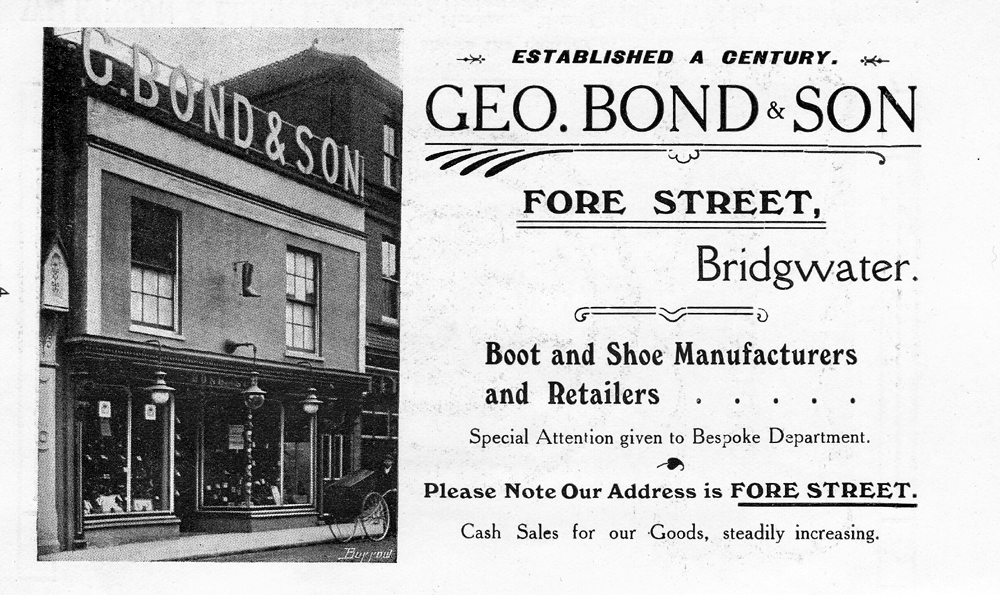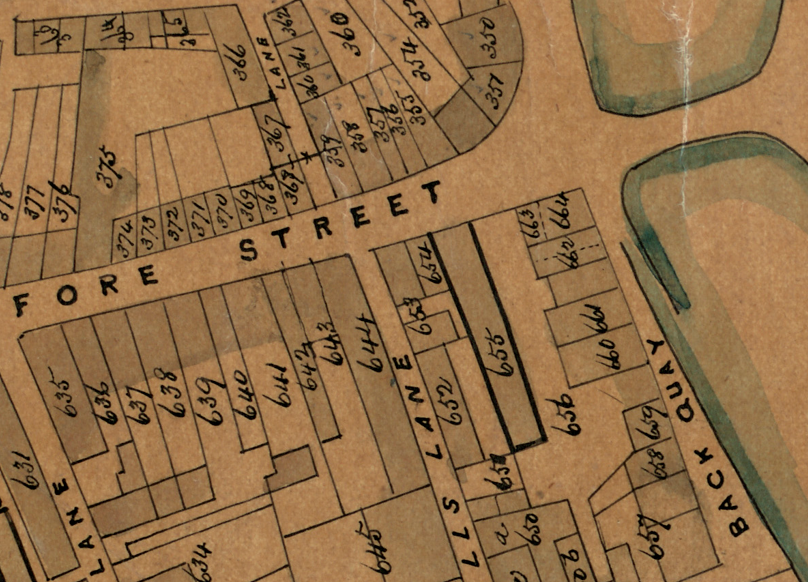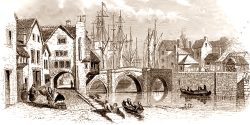Philip Lock was born in Bishops Hull, Taunton and baptised there on 26th February 1819. By the 1841 census (HO107/971/3) he was in Bridgwater, lodging in Fore Street in the house of George Bond and family, and operating as one of nine hairdressers listed under Bridgwater in the 1842 Pigot´s Directory of Somersetshire.
One dark night in January 1843 Philip’s life was about to change dramatically, and he and George were to appear in newspapers across the county and beyond. On Saturday 14 January 1843 the Bristol Times and Mirror reported:
“On Thursday last, a young man, by name Philip Lock, was committed to Wilton Gaol by the Mayor of Bridgwater, charged with shooting at George Bond, with intent to kill him. The circumstances were these; – Lock is a hairdresser, and has been for some years lodging in Bond’s house, and occupying a shop looking into the street: several disagreements had occurred between Bond and Lock, and some ill feeling arising therefrom existed between them. Lock had been tippling a good deal during some days, and was in a very excited state. Early in the morning of Wednesday, he bought a pistol, and had several bullets cast, which he left until the evening, when he fetched them; during the day he was heard several times to ask for Bond, who was from home, – Bond returned home in the evening, and between 8 and 9 o’clock, as he was entering a passage at the back of the house leading through the court to Ball’s Lane [King Street], Lock, who was distant about four feet from him, fired the pistol at him, but missed him; Lock was immediately taken into custody, and the pistol, balls and powder found upon him; up to the time of this occurrence, he had been considered a quiet, inoffensive young man, but latterly he had been studying Owen’s New Moral World, and The Northern Star. – We hear that since his committal, it has been necessary to place him in the lunatic asylum of the gaol.”

We see from the Wilton Gaol Description Book (South West Heritage Trust ref Q/AGW/15/5) that Philip was admitted to the gaol on 5th January 1843, aged 22. He was 5’6” tall, with a fair complexion, hazel eyes, dark brown hair, and had a mole on the left side of his chin. He was single.
The article from the Bristol Times and Mirror tells us that, based on his reading material, he was interested in socialism and the Chartist movement.
Philip remained in Wilton Gaol awaiting the Somerset Lent Assizes after which the newspapers again come alive with the reports of the trial and sentencing. His trial was on 13th March 1843, so he was in Wilton Gaol for just short of 10 weeks.
In the various trial reports in the newspapers a few other details came out – such as this from the “English Chronicle and Whitehall Evening Post” of 18 March 1843:
“Philip Lock was indicted for shooting at George Bond with intent to murder him. There were counts in this indictment varying the intent. Mr. EDWARDS conducted the prosecution. The prisoner was defended by Mr. STONE. The witnesses disclosed these facts. The prosecutor is a boot and shoemaker, residing at Bridgwater. The prisoner was a hairdresser, living at the same place, and in a part of the same house as the prosecutor. Nearly nine months since a quarrel took place between the parties; the cause was not stated, but we have been informed that it was respecting some young lady who was staying at the time at the prosecutor’s. It appears from that time that the prisoner had nursed a secret hatred of the prosecutor, Mr. Bond, and had stated a few days before that he would settle him, and to a young man, sometime before that, that he knew he would one day be hung for Bond. On the 4th January he went to a shop and purchased a pistol. He requested that balls might be prepared, which the person selling the pistol promised should be done, and he was desired to call again on that day to receive them. About seven o’clock in the evening he called, and took away eleven of the bullets that had been prepared, leaving one behind. Before he went out of the shop he loaded the pistol. Mr. Bond had been out of town that day. he did not return till about eight o’clock. His servant was at the door, and led his horse through a passage into the back part of the premises where Mr. Bond’s stable was situated. After waiting here a few minutes to see his horse attended to, he proceeded to the house. To do this he had to pass the door of a privy in the yard, at which the prisoner was standing. Directly as Mr. Bond came up to him he raised his arm and fired. He was then secured by Mr. Bond and his servant, and taken to prison. The ball was then discovered in the wall. Mr. STONE addressed the jury, insisting that the intent of the prisoner was only to frighten the prosecutor, and not to murder or injure him. After hearing the able remarks of the learned judge on the case, the jury returned a verdict, that the prisoner fired the pistol, with intent to do some grievous bodily harm. Sentence was deferred.”
The “Bath Chronicle and Weekly Gazette” of 23 March 1843 tells us that the servant’s name was Marks, and that the gunsmith was George Rossiter. Another witness was Samuel Hooper, foreman to George Bond.

Philip was sentenced to transportation for 15 years.
On 5th April there was an order for Philip and thirteen other men convicted at the assizes and sentenced to transportation to be removed from Taunton to the Stirling Castle convict hulk situated at Plymouth Devonport (See National Archives HO13/82/176 Correspondence and Warrants). Of these other men, William Matthews was also from Bridgwater, a 21 year old, married labourer. He was convicted of “stealing monies from a person” and sentenced to 10 years’ transportation.

The 14 men were taken to the Stirling Castle prison hulk to await transportation (they make up consecutive entries in the Stirling Castle Register (TNA PCOM/134/75). Of the 14, two died on the Stirling Castle, two were sent to Australia, and eight (including William Matthews) were sent to Bermuda to work as labourers building the naval yards. The final two, including Philip, remained on the Stirling Castle until they were eventually pardoned in 1848 and 1849. During that time, in October 1844, the Stirling Castle hulk was towed to Portsmouth harbour.
Following his conviction, Philip’s family and friends petitioned the government to have him pardoned. The petition makes fascinating reading and includes lots of signatures of people from Bridgwater and Bishops Hull/Taunton, including George Bond, and W. D. Bath, the Mayor of Bridgwater. The petition, covering letter, and responses are in the National Archives, reference HO18/108/382. The names are transcribed as follows:
| George Bond Prosecutor | John Marlier Baker | Wm Smith Grocer |
| W. D. Bath Mayor of Bridgewater | John Giles Davis Upholsterer | William Baker Gent |
| Charles Wm. Rice Surgeon | G Tice Draper etc. | Tho Bishop Draper |
| John Howell Cook Gent | James Price Plumber | Wm Teller Grocer |
| Rich Cave Gent | Chas Faun Printer | William Whitefield Grocer |
| Thomas Ford Solicitor | I L Varder Chemist | George Trutt Ironmonger |
| Sam Trueman Gent | Jas Foster China Man | H J Knight Upholsterer |
| John Snowden Gent | William Groker Grocer | Jn B Bishop Tindealer |
| Wm. Gunston Maclean Comm RN | James Leake Maltster | Chas Hunt Merchant |
| George Eden Peake MA Curate Ruishton, Somerset | Daniel John Down Draper etc. | James Hunt Jeweller |
| Thos E King Clerk | Joseph Peacock Grocer | C Hallaway Gent |
| William Wetter Gent | Thos Noakes Best Accountant | J M Good Grocer |
| William Down Cooper | Reuben Craven Payne Chemist | John Whitby Bookseller |
| Samuel King Smith | G Rossiter Silversmith | F J Thompson Ironmonger |
| James Lear Tailor | Robert Hooper Draper etc. | Charles Thompson Ironmonger |
| Thomas Trick Grocer | W H Smith Draper | Thomas Furby Grocer |
| James Brice Innholder | Chas B Hooper | Reuben Bond Bootmaker |
| Edwd. C Priest Plumber etc. | Joseph Marden Hatter | Charles Lean Hair Dresser |
| John Sear Hairdresser | George Dean China Man | Thomas Sollen Grocer |
| Geo. Collis Confectioner | Thomas Slocombe Cabinet Maker | William Mansfield Tailor |
| James Ware Merchant | G Shul Boot and Shoe Maker | J T Allen Gent |
| William Poole Grocer | D. Philipps Draper | George Mole Corn Factor |
| Thos Patton Gent | Geo Tucker Tailor etc. | W James Gent |
After his release, Philip moved to Shoreditch in London where he continued as a hairdresser. In 1851 he is a shopman for a widow hairdresser, Mary Ann MacDonald (nee Lockwood). By the 1861 census he had married Mary Ann and they had five children. Sadly, by the 1871 census the family were apart, Mary Ann was a patient in St Thomas Hospital, Philip was at Colney Hatch Asylum and the children were boarded out. By 1881 Philip had moved to Leavesden Lunatic Asylum, where he died in 1890. It appears that he had suffered mental illness for a lot of his life.
Andy King 25 October 2025
Notes on names in the petition:
- John Giles Davis 1809-1890 was a master cabinet maker and upholsterer – full biography on the website of the Friends of the Wembdon Road Cemetery.
- Thomas Ford, elected Mayor in 1852. Donated a stained glass window to St Mary’s Church.
- Charles Hunt 1810-1892, Mariner & Ship Broker. Behind the Burnham-on-Sea Lifeboat. Full biography on the website of the Friends of the Wembdon Road Cemetery.
- Dan Walter Philipps c1795-1869, draper. Full biography on the website of the Friends of the Wembdon Road Cemetery.
- Francis James Thompson 1813-1897, mayor in 1884. Read more in Sturge’s History. Buried Albert Street Quaker burial ground.
- Charles Thompson 1815-1889, brother of Francis – went to Cardiff to work for Spillers. Behind Thompson’s Park in Cardiff.
- James Ware, 1786-1882, Master Mariner and Dockmaster. The family give their name to Ware’s Warehouse at the docks and Ware’s Lane in Wembdon. Full biography on the website of the Friends of the Wembdon Road Cemetery.
